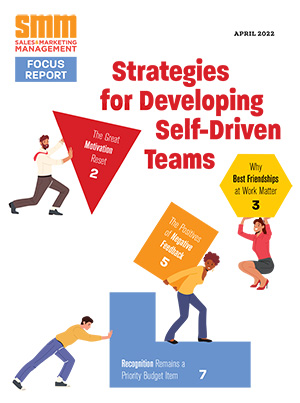 Editor’s Note: Sales and marketing teams devote countless hours in group sessions to “innovating” and all that word encompasses. Whether it’s developing a new sales presentation, creating a strategy to support new product introductions, or setting new objectives, innovation sessions should produce strong ideas for bold new campaigns.
Editor’s Note: Sales and marketing teams devote countless hours in group sessions to “innovating” and all that word encompasses. Whether it’s developing a new sales presentation, creating a strategy to support new product introductions, or setting new objectives, innovation sessions should produce strong ideas for bold new campaigns.
So why don’t they?
Martin Murphy, author of the new book “No More Pointless Meetings: Breakthrough Sessions That Will Revolutionize the Way You Work” (AMACOM), says too many meetings accomplish their goals because they follow an outdated structure. “Conventional meetings are obsolete — even when conducted with state-of-the-art technology,” he says.
His book offers solutions for conducting more productive meetings in four broad categories: issues management, innovation, problem solving and ongoing planning.
In this excerpt, he explains why meetings fail and what to do about it.
In a digital age, conventional meetings are obsolete. When compared to advances in other areas of organizational management, the current art of human collaboration seems archaic. It needn’t be.
I can walk into any conference room cold, without any prior knowledge of the organization or the meeting that is about to begin, and lead it in a manner that gets more done in a shorter period of time than anyone in the room has ever experienced. The get-together can be with the board of directors, top executives, departmental managers, supervisors, team leaders or any mix of people and disciplines; it doesn’t matter.
I get superior results every time I facilitate a collaborative event — because I don’t use meetings for collaboration.
Meetings have survived as the primary collaborative process because it is assumed that an individual, once promoted to a leadership position, already knows how to effectively leverage human capital. The facts don’t support this — all of us still get trapped in meetings that squander time we’ll never recover.
For most executives, managers and supervisors, the meeting is the only work management tool they’ve ever used for collaboration. The drill is ingrained: Everyone gathers in a conference room, and the most senior executive both conducts and participates in the meeting at the same time. This wasteful collaborative ritual takes place millions of times daily in organizations around the globe. While its shortcomings are acknowledged, it has been the principal means for collaboration over the course of many generations.
Guiding principles
Reframing workflow management activities into four broad categories of need transforms the effectiveness of workflow management in general and collaboration in particular. Those categories — the need to manage issues,
to solve problems, to innovate and to plan — yielded the following collaborative elements of a workflow management system:
• The Issues Management Session
• The Innovation Session
• The Problem-Solving Session
• Ongoing Planning
There are two principles on which all of these sessions are based:
1. Content and process must be kept separate.
2. The boss (or highest-ranking person in the room) should not run workflow management sessions.
Separate content and process
While there’s little doubt about the need to upgrade the quality of workplace collaboration, how to do so can be a challenge. The place to begin is with
the core elements of all interpersonal communications: content and process. Content refers to what is being discussed, the subject or purpose for having a meeting in the first place. Process refers to virtually everything else. For example:
- How loudly are people speaking?
- Who’s talking the most?
- Who’s apparently not listening?
- Who’s participating?
- How long is the meeting scheduled to run?
- Is there a spirit of openness and teamwork?
- Is the boss present?
- Are things getting accomplished?
Most collaboration problems occur in the arena of process, not content. This happens because most managers focus on content and ignore process. While content and process are equally important, few managers understand the importance of separating them or possess the ability to do so.
All workflow management sessions have a facilitator who leverages the collective intellectual and creative potential of the group. This facilitator orchestrates the session in a manner that enables the group to get more done in a shorter amount of time than in a regular meeting.
Collaboration is transformed by the simple act of keeping content and process separate. Facilitators don’t participate in content discussions. Their job is to handle process only and to do so in a manner that motivates all participants to contribute to the maximum of their ability.
Entry points
Three dynamics — Entry Points, Leverage and Questions — play a key role in upgrading the quality of thought that drives intellectual performance in general and problem solving in particular. These interrelated tools enable a dramatic upgrade of the cognitive capabilities of managers and supervisors.
The Entry Points are created by the questions we ask to better understand the precise nature of the issue being addressed or the problem to be solved. How often have you experienced the frustration of being unable to resolve a problem and then discovered you’ve been addressing the wrong problem or going down the wrong path? This is usually the result of choosing the wrong Entry Point in the problem-solving process.
Most managers operate from the perspective of what they do know as the Entry Point to solve problems and resolve issues. This is actually the converse of effective problem solving. As you’ll see, the problem-solving session begins with an exploration of what we don’t know rather than a reiteration of what we do know. Once there is agreement about the definition of the problem, you’ll be able to guide the group to identify the best Entry Point for tackling the problem. The selection of a strong Entry Point is the most crucial step in the problem solving and issue resolution process.
Given the nature of our technology-driven global economy, all organizations and institutions must be innovative entities to remain relevant, let alone competitive. While it’s no secret that the speed with which technology is evolving is not matched by the human factor, I believe that every organization already employs the intellectual and creative talent it needs to be successful. The fly in the ointment is the fact that few managers know how to leverage the intellectual and creative resources of the individuals who report to them.
Collaborative sessions empower managers to leverage human capital and develop innovation and speed-to-market capabilities — vital competencies for success in the digital age.


